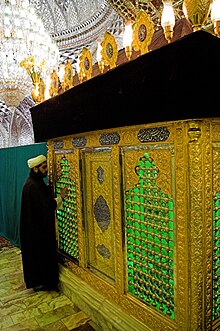|
Mullah
 Mullah (/ˈmʌlə, ˈmʊlə, ˈmuːlə/) is an honorific title for Muslim clergy and mosque leaders.[1] The term is widely used in Iran and Afghanistan and is also used for a person who has higher education in Islamic theology and sharia law. The title has also been used in some Mizrahi and Sephardic Jewish communities in reference to the community's leadership, especially its religious leadership.[2] EtymologyThe word mullah is derived from the Persian word mullā (Persian: ملا), itself borrowed from the Arabic word mawlā (Arabic: مولى), meaning "master" and "guardian", with mutation of the initial short vowels.[1] UsageHistorical usage The term has also been used among Persian Jews, Bukharan Jews, Afghan Jews, and other Central Asian Jews to refer to the community's religious and/or secular leadership. In Kaifeng, China, the historic Chinese Jews who managed the synagogue were called "mullahs".[3] Modern usageIt is the term commonly used for village or neighborhood mosque leaders, who may not have high levels of religious education, in large parts of the Muslim world, particularly Iran, Turkey, Caucasus, Central Asia, West Asia, South Asia,[4] Eastern Arabia, the Balkans and the Horn of Africa. In other regions, a different term may be used, such as imam in the Maghreb.[4] In Afghanistan and Pakistan, the title is given to graduates of a madrasa or Islamic school, who are then able to become a mosque leader, a teacher at a religious school, a local judge in a village or town, or to perform religious rituals. A person who is still a student at a madrasa and yet to graduate is a talib. The Afghan Taliban was formed in 1994 by men who had graduated from, or at least attended, madrasas. They called themselves taliban, the plural of talib, or "students". Many of the leaders of the Taliban were titled Mullah, although not all had completed their madrasa education.[5] Someone who goes on to complete postgraduate religious education receives the higher title of Mawlawi.[6] In Iran,[12] until the early 20th century, the term mullah was used in Iranian seminaries to refer to low-level clergy who specialized in telling stories of Ashura, rather than teaching or issuing fatwas. However, in recent years, among Shia clerics, the term ruhani (spiritual) has been promoted as an alternative to mullah and akhoond, free of pejorative connotations.[13] Training and dutiesIdeally, a trained mullah will have studied the traditional Islamic sciences not limited to:
Some mullahs will specialise in certain fields after completing the above foundational studies. Common specialties are:
Such figures often have memorized the Quran and historically would memorise all the books they studied. However in the modern era they instead memorise the founding books of each field (sometimes in the form of poetry to aid memorisation). Uneducated villagers may frequently classify a literate Muslim with a less than complete Islamic training as their "mullah" or religious cleric. Mullahs with varying levels of training lead prayers in mosques, deliver religious sermons, and perform religious ceremonies such as birth rites and funeral services. They also often teach in a type of Islamic school known as a madrasah. Three kinds of knowledge are applied most frequently in interpreting Islamic texts (i.e. the Quran, hadiths, etc.) for matters of Sharia, i.e., Islamic law. Mullahs have frequently been involved in politics, but only recently have they served in positions of power, since Shia Islamists seized power in Iran in 1979. Dress The dress of a Mullah usually consists of a turban (Persian: عمامه ammāme), a long coat with sleeves and buttons, similar to a cassock (قبا qabā), and a long gown or cloak, open at the front (عبا abā). The aba is usually made either of brown wool or of black muslin. It is sleeveless but has holes through which the arms may be inserted. In Shiism, the turban is usually white, but those who claim descent from Muhammad traditionally wear a black turban.[14] Sunni Mullahs generally wear neutral colored turbans, with some sufis choosing green as preferred color.[citation needed] See alsoReferences
External links |